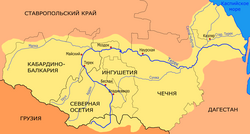Terek (river)
(Redirected from
Terek River
)| Terek | |
|---|---|
 Map of Terek river | |
| Location | |
| Countries | |
| Region | Mtskheta-Mtianeti |
| Federal subjects | |
| Physical characteristics | |
| Source | Mount Zilga-Khokh |
| • location | Main Caucasian Range Greater Caucasus, Georgia |
| • coordinates | 42°36′57″N 44°14′22″E / 42.6159°N 44.2395°E |
| • elevation | 2,700 m (8,900 ft) |
| Mouth | Caspian Sea |
• coordinates | 43°35′43″N 47°33′42″E / 43.595278°N 47.561667°E |
• elevation | −28 m (−92 ft) |
| Length | 623 km (387 mi) |
| Basin size | 43,200 km2 (16,700 sq mi) |
| Discharge | |
| • average | 305 m3 (10,800 cu ft) per second |



The Terekhydroelectric power in its upper reaches.
The main cities on the Terek include Vladikavkaz, Mozdok, and Kizlyar. Several minor hydroelectric power stations dam the Terek: Dzau electrostation (in Vladikavkaz), Bekanskaya, and Pavlodolskaya.
The construction of the
MW started in 2011 on the territory of Kazbegi municipality near the Russia–Georgia border.[1]
Leo Tolstoy's novel The Cossacks is set on the Terek and amongst its Cossacks.
Tributaries
The Terek drains most of the northeast Caucasus east into the Caspian just as its sister, the
Sulak
drains most of interior Dagestan and turns east to the Caspian before it reaches the Terek.
Human history
The capital of
Khazaria, Samandar
, may have stood on the banks of the river Terek.
The Terek river was the site of the final defeat of the army of
Hulagu, khan of the Ilkhanate, at the hands of the army of Berke, khan of the Golden Horde, led by Berke's nephew, Nogai Khan, in the first civil war of the Mongol Empire, the Berke–Hulagu war of 1262. Also on the river Timur defeated Tokhtamysh
in 1395.
The
Terek Cossack Host (1577–1832 and 1860– ) had its base in the Terek basin. During the Russian conquest of the Caucasus it was part of the North Caucasus Line
.
During World War II, German forces at the end of August 1942 reached the Terek near
Mozdok – the farthest extent of German conquests in the Soviet Union – but aside from a small bridgehead were unable to forge further toward the oil fields of Baku, Hitler's objective.[2]
The Germans penetrated the left bank of the Terek reaching Vladikavkaz suburbs and West Gizel, near the now built weather station.
See also
Notes
References
- ^ Dariali Hydro Power Plant Construction and Operation Project (Environmental and Social Impact Assessment Reportt). Darial Energy LLC. Issued in 2011. Retrieved on 2014-16-07.
- ^ Schramm, Percy Ernst (1963). Kriegstagebuch des Oberkommandos der Wehrmacht, 1940–1945 Teilband II. Bonn: Bernard & Graefe Verlag für Wehrwesen, p.583.
